Finally, the über Golf has been confirmed by Volkswagen! The Golf R, complete with a fully revised 4motion all-wheel drive system, 199kW and 350Nm of torque, can accelerate from rest to 100km/h in 5.5 seconds when fitted with a DSG box, or 5.7 seconds for the manual version.
Over the model it replaces, the V6 powered R32, the new Golf R increases peak power by 15kW and maximum torque by 20Nm. With fuel consumption rated at 8.5l/100km the 2-litre four cylinder TSI reduces fuel use by a very respectable 21 per cent. CO2 emissions drop from 255g/km to 199g/km, or a reduction of 28 per cent.
Stopping power is provided by 345mm sized front discs, with barely smaller 310mm rotors at the rear. The R comes standard with 18″ Talladega alloys, fitted with 225/40/18 rubber. Larger 19″ wheels in the same style can also be optioned with 235/35/19 tyres. The ESP system has been tweaked and given a Sport setting that allows for greater slip in aggressive track-like driving situations.
Apart from the more obvious body styling, the Golf R sets itself apart from the rest of the Golf range by the latest bling lighting fad, with LED daytime running lights at the front and, for the first time on a Golf, LED rear tail lights.
The Golf R really is an Audi S3-lite. Brilliant! Just how “lite” will the pricing be, and when will we see the Golf R on Australia soil? You can ponder these questions while checking out the pics and reading Volkswagen’s press release after the jump. A reminder, too, that all pics can be viewed as wallpaper friendly 2000px super images by clicking on each image.
UPDATE 6 April 2010: 20 new images added at end of article.
Volkswagen Golf R
- World Premiere of Top Golf with 270 PS Performance: New Golf R consumes up to 21 percent less fuel
- Frugal – Golf R with most powerful TSI ever consumes just 8.5 litres
- Exceptional – All-wheel drive top Golf shows superlative handling
- Distinctive – First sixth generation Golf to display new LED taillights
Wolfsburg / Frankfurt, 15 September 2009 – Automotive passion – even in 2009 it still has something to do with power and performance. At the IAA, however, Volkswagen is demonstrating – in the world premiere of the new Golf R – that fuel consumption values can even be corrected downward in the high-end sports car area. And indeed without even a hint of a compromise in dynamic performance. On the contrary. Traditionally each new R version of this model series bears the title “strongest Golf of all times.†With a power of 199 kW / 270 PS (at 6,000 rpm), the new Golf R is continuing in this dynamic tradition; the previous model transferred 184 kW / 250 PS to its all-wheel drive system. The highlight here: While the now retired Golf R32 processed 10.7 litres of fuel through its fuel injection system every 100 kilometres, on the new Golf R the figure is just 8.5 litres – 2.2 litres or 21 percent less! CO2 emissions were reduced from 255 to 199 g/km. Like all R models, this one was also conceptualised by Volkswagen Individual.
In parallel, its performance data advanced as well. The new Golf R sprints from 0 to 100 km/h – also via all-wheel drive – in 5.7 seconds. On the previous model, the stopwatch stopped at 6.5 seconds. The new model puts the 1,000-meter mark behind it in 25.4 seconds, while the already masterful Golf R32 shot past this mark in 26.7 seconds. The Golf R does this even better with the optional DSG gearbox, sprinting to 100 km/h in a sensational 5.5 seconds and requiring just 8.4 litres petrol per 100 kilometres (equivalent to 195 g/km CO2) at the fuel pump.
The enormous efficiency gain of the new Golf R is not based on some magical trick, rather it is the result of highly advanced downsizing. Its legendary predecessor generated its power from a displacement of 3.2 litres (“32â€) and six cylinders. In the new model, this is done with four cylinders and 2.0 litres of displacement – a highly advanced direct injection petrol engine with turbocharging (TSI). At the fuel pump and on the winding mountain road, this high-tech alliance is superior to a classic six cylinder unit with multi-point injection. Proving that even the sound of a four cylinder can leave a strong impression are the fifth and sixth generations of the Golf GTI, which is also powered by a four cylinder TSI. And the Golf R exhibits an even greater “sound range.â€
The TSI’s torque characteristic is just as impressive. By comparison: The six cylinder of the previous model developed a maximum torque of 320 Newton-meters at 2,500 rpm. And that was already remarkably good. The turbo four-cylinder direct injection engine of the new Golf R, on the other hand, transfers 350 Newton-meters torque to the crankshaft, which is also available starting at 2,500 rpm, but it can maintain this peak value up to 5,000 rpm. So the new car delivers a fascinatingly high level of basic dynamic performance. The Golf R32 and Golf R are really only equal in one discipline; they both have a top speed of 250 km/h (electronically limited on the Golf R).
TSI of the Golf R
The EA113 series direct-injection petrol engine is used in the new Golf R; its turbocharger makes it very flexible and variable right up into the highest performance ranges. The 1,984 cm3 TSI’s specific power is a respectable 100.3 kW / 136.6 PS per litre displacement, and its response is just as impressive. The engine’s power can be spontaneously summoned in the blink of an eye throughout its speed range. The engine also impressively underscores its potential acoustically. Visually too: Its two chrome tailpipes can be seen at the centre of the bumper under the diffuser integrated there – an “R trait†that the previous model also displayed.
The in-line four-cylinder engine develops its tremendous propulsive power via a turbocharger (up to 1.2 bar boost pressure) with intercooling. The engine, with a weight of just 152 kilograms, is controlled by a fully electronic engine management system with E-Gas. The cylinders of the four-cylinder engine have been equipped with reinforcing bolts, unlike less powerful TSI versions. Also designed to be stronger are the connecting rods, so that they can reliably transfer the engine’s high torque to the crankshaft. Last but not least the cylinder block was also reinforced to handle the aggressive engine forces.
New all-wheel drive on the Golf R
As standard equipment, the Golf R transfers the TSI’s power to the road via the latest generation of Volkswagen’s 4Motion all-wheel drive system. Compared to the version implemented in the Golf R32, the system underwent significant advanced development. Above all, power transmission between the front and rear axles – especially the all-wheel differential that operates in an oil bath – exhibits clear advances compared to the previous generation. The most important one: Activation of the all-wheel differential no longer requires a difference in speeds between the front and rear axles.
That is because, different than on the previous generation, for the first time an electric pump is used to build pressure. The electric pump supplies oil to a hydraulic reservoir whose working pressure is 30 bar. A control module computes the ideal drive torque for the rear axle and controls, via a valve, how much oil pressure is applied to the working pistons of the multi-plate clutch. The contact pressure at the clutch plates rises in proportion to the desired torque at the rear axle. The amount of torque that is transferred can be varied continuously with the magnitude of the pressure applied to the clutch plates. Compared to the previous 4Motion generation, the system operates independent of slip, since the system’s working pressure is always available. When starting up and accelerating, this prevents spinning of the wheels at the front axle more effectively, since the control module regulates the torque distribution based on dynamic axle loads. In extreme cases, nearly 100 percent of the drive torque can be directed to the rear axle. This results in further gains in active safety and dynamic performance.
Sport chassis and brakes on the Golf R
When it came to the chassis, development engineers were able to adopt the first-class system in the current production Golf. This means: In front the familiar McPherson strut suspension with helical springs and telescoping shock absorbers; and at the rear a multi-link suspension ensures that the standard ESP seldom needs to intervene. Nonetheless, the basic layout was transformed into a sport chassis with ride-height lowered 25 millimetres, and the springs, dampers and stabilisers were completely retuned to match.
The brake system was also modified for the higher level of driving performance on the Golf R. In place of a 16-inch system, a 17-inch brake system is used with internally ventilated discs all around and R-specific brake calipers painted a high-gloss black with R logo. In front the discs are 345 millimetres in diameter, and 310 millimetres at the rear. The electronic stabilisation program (ESP) was also modified. It can be switched to a new Sport mode via the ESP button. During very fast and curve-filled drives – as on a motorsport race course – the ESP system delays intervention, enabling even more responsive handling properties. The electro-mechanical power-assist steering of the Golf R was also given a sportier characteristic. If the sports car is ordered with the optional DCC dynamic chassis control option, the power-assist steering even assumes a specially tuned characteristic for each of the system’s driving modes (Sport, Normal, Comfort).
The chassis maintains contact with the road through its standard newly designed 18-inch alloy wheels (“Talladega†type) with 225/40 tyres. As an option, the same wheels are available in a 19-inch version with 235/35 tyres.
Exterior features of the Golf R
Like the first two generations of the Super Golf (I starting in 2002, II in 2005) and the new sister model, the Scirocco R, the new Golf R too sports a completely modified set of exterior and interior features. Volkswagen designers, led by Klaus Bischoff, have given the Golf R an independent image with a bundle of well-coordinated refinements. The Golf R unmistakably marks the peak of the model series, and the quality of its styling follows the basic postulate of “La Semplicità †set forth by the Head of Group Design, Walter de Silva.
Outside, the customisation includes new wheels and brakes as well as new bumper designs. In front, three very large air intakes characterise the Golf R in the bumper area; the louvres on the intakes are painted in high-gloss black, and standard LED strips that serves as daytime running lights are integrated in the two outer air intakes. Also painted in high-gloss black are the two louvres of the radiator grille. Placed on the right side of the grille is the newly designed R logo in chrome. Bi-Xenon headlights, included without surcharge, illuminate the way through the night. On its sides, the Golf R is identified by its Talladega wheels, side skirt extensions in car colour and mirror housings painted in high-gloss black.
It is also possible to recognise the Golf R as an independent top model at the rear. Along with the bumper with diffuser and tailpipes, R logo and larger roof edge spoiler, the newly developed taillights stand out. They operate with standard, distinctive LED technology. The taillight covers are also smoked.
Interior features of the Golf R
The sixth generation Golf, with its high-end interior materials, breaks through boundaries to the next higher class. The Golf R also benefits from this quality image; it is in a league of its own based on its power reserves. Additional special upgrades developed by Volkswagen Individual underscore the car’s high-class positioning.
A key equipment option here is the newly designed “Top Sport seat system†with its excellent ergonomic properties. The driver just sits down, adjusts the seat longitudinally and in height, adjusts the steering wheel, buckles up, and is ready to go. The seat fits as though tailor-made. Together with the similarly customised Golf GTI and Golf GTD, the Golf R sets standards here among the international competition. The centre panels of the sport seats are upholstered in the honeycomb textured grey-black “Kyalami†design – named after the race course by the same name in South Africa. The front edge of the seat is upholstered in Titan Black fabric, while the inside panels of the side supports are upholstered with crystal-grey “San Remo†micro-fibres. The rest of the seat components and the roofliner are coloured black. The new R logo is embroidered in the front head restraints as well. Motorsport shell seats for driver and front passenger are also available as an option. In this case, the centre seat panels are upholstered in the “San Remo†micro-fibre fabric. On the outside, the shell seats are covered with black leather.
All seams of the interior are in “Art Greyâ€; this is also true of the decorative seams on the three-spoke leather steering wheel. Perforated leather is used at the top and bottom of the steering wheel, ensuring maximum hand grip. The sides of the steering wheel featuring ergonomic motorsport attributes are covered by continuous leather. Spokes in fine black piano paint add an elegant aspect to complete the sporty image. The centre steering wheel spoke bears the new R logo. The fascinating material contrast of piano paint and chrome conveys an image of the passion for finesse and precision in every detail.
Other new design features include the R gearshift knob, carpet floor mats, aluminium door tread plates with R logo and the instruments with their blue pointers. Stainless steel sport pedals and R-specific instrument and door accents in “Silver Lane†style complete the customisation. Another standard feature on the Golf R is an automatic climate control system (“Climatronicâ€), “RCD 310†radio-CD system (4 x 20 Watt) including MP3 player plus dual tuners. The Golf R can be ordered in Germany starting at the end of this year.
Note:
All data and equipment contained in this press release apply to models offered in Germany. They may differ in other countries. All information is subject to change or correction. TDI, TSI, DSG and Twincharger are registered trademarks of Volkswagen AG or other companies of the Volkswagen Group in Germany and other countries.
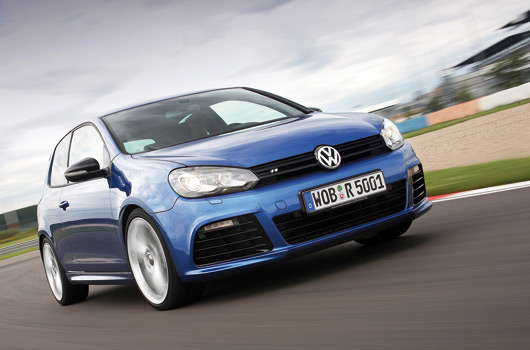
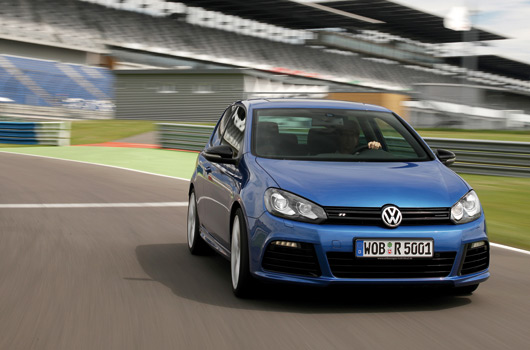
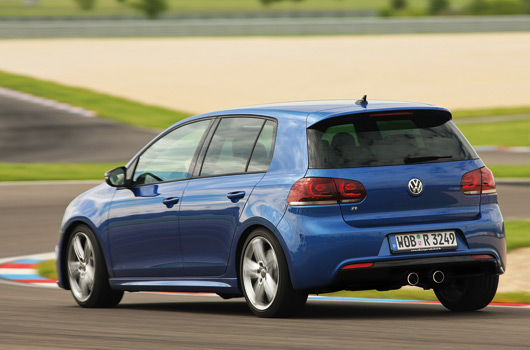
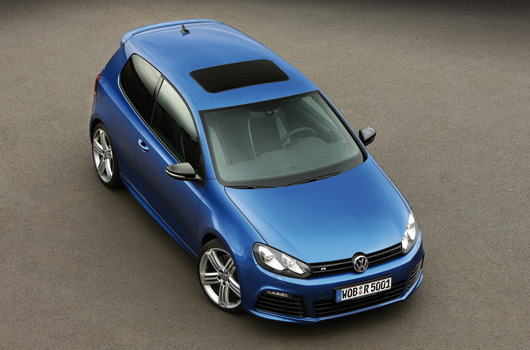
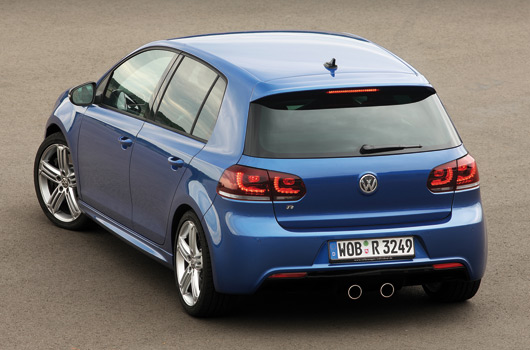
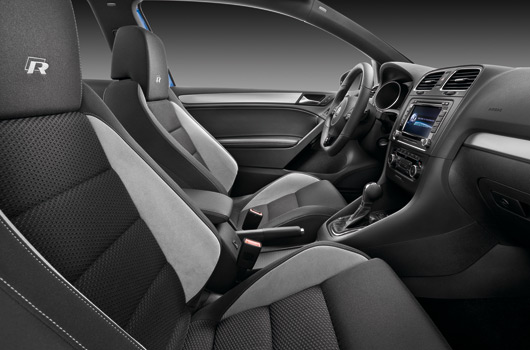
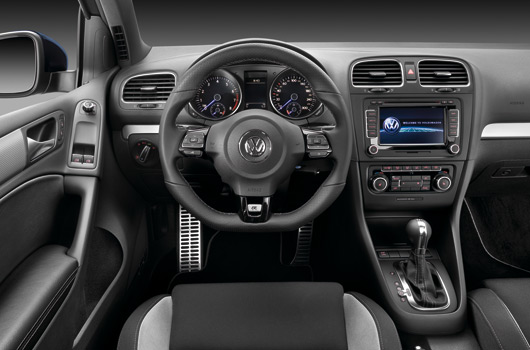
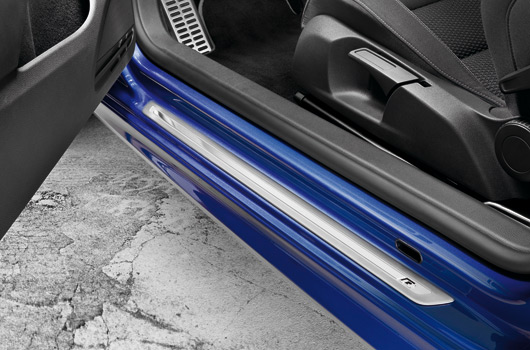
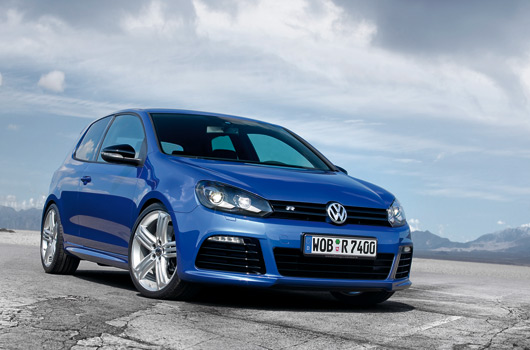
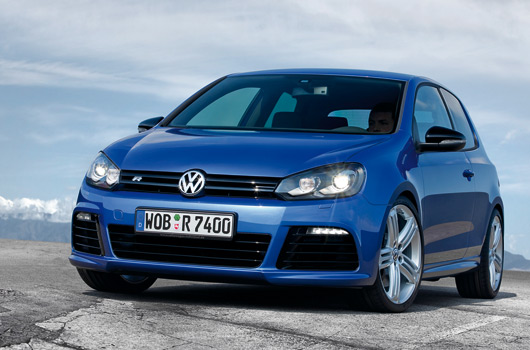
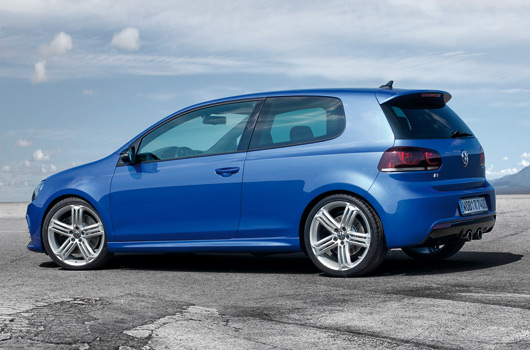
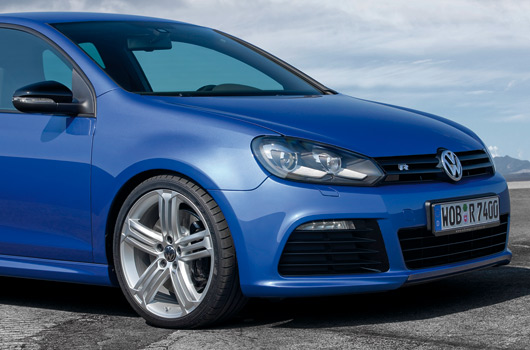
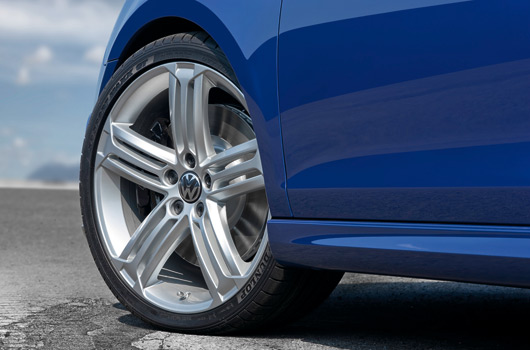
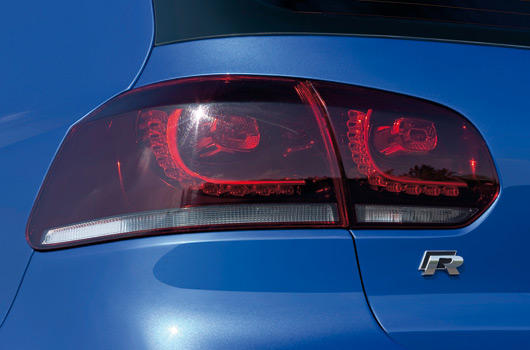
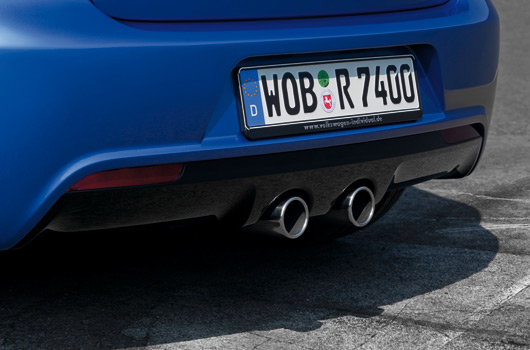
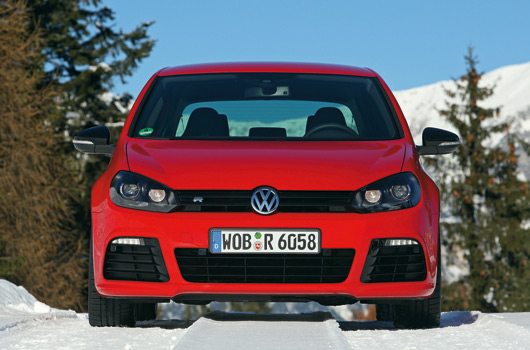
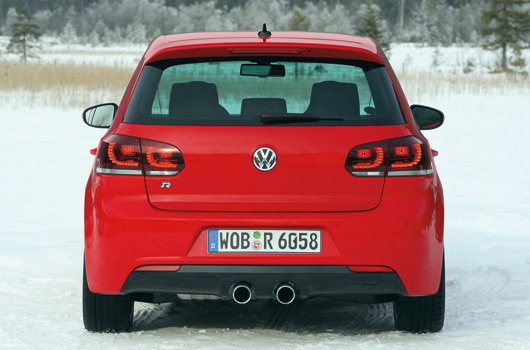
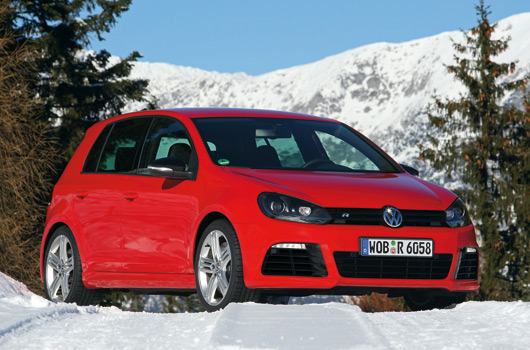
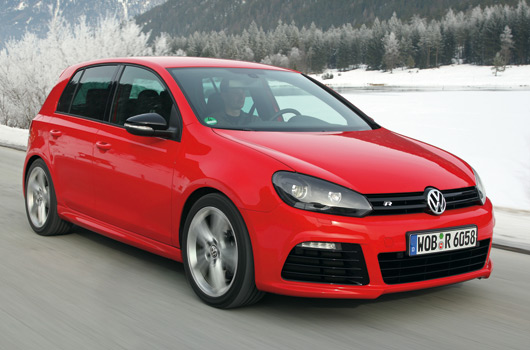
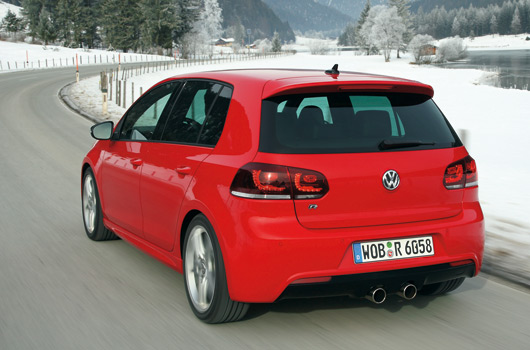
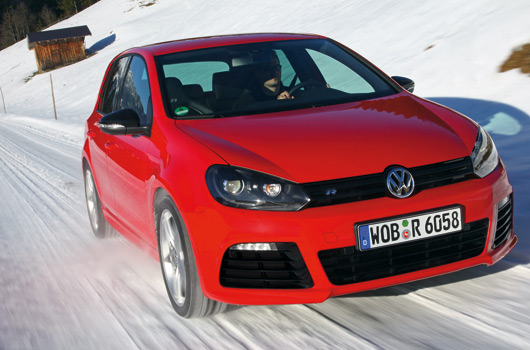
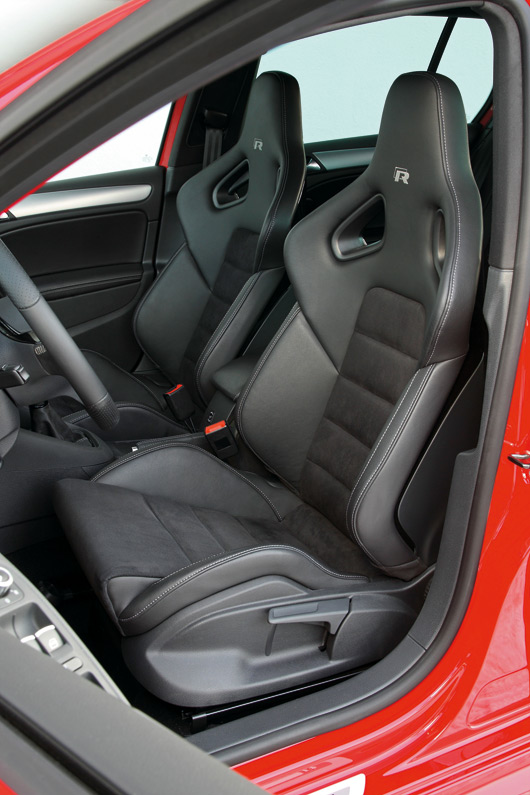
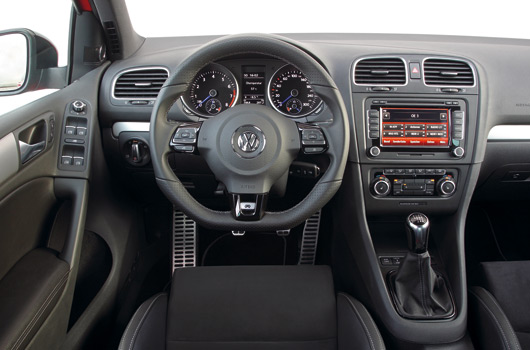
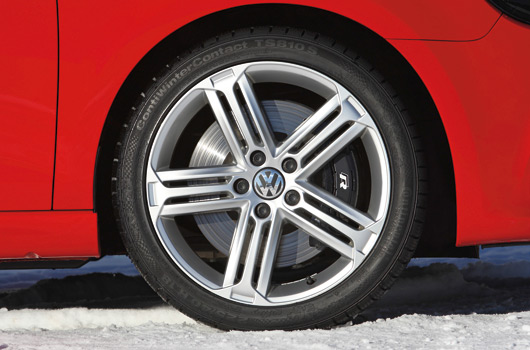
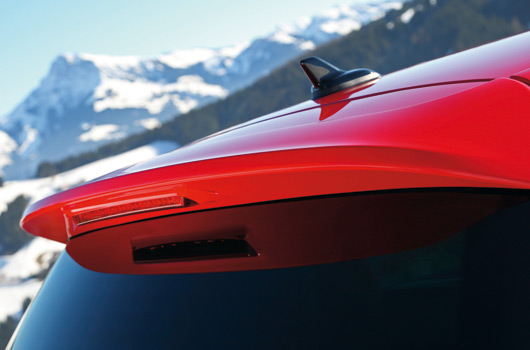
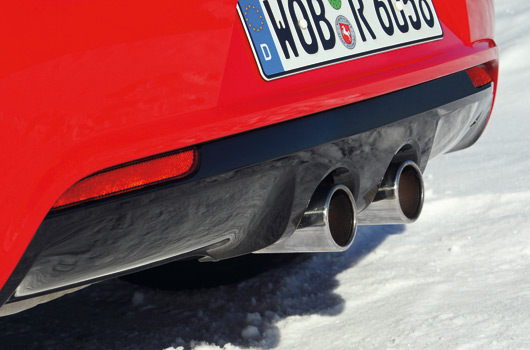
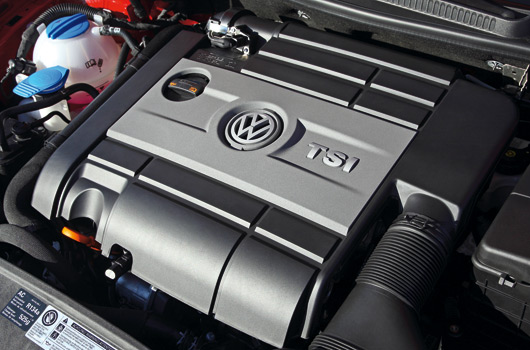
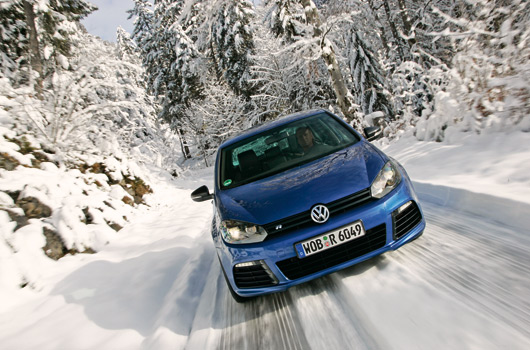
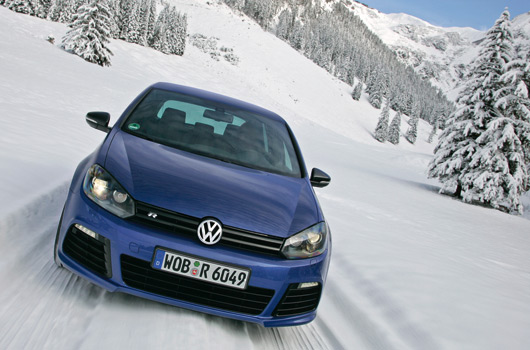
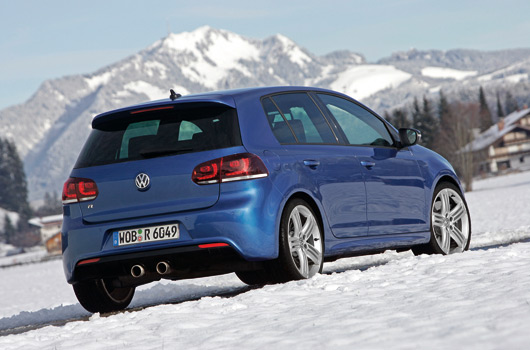
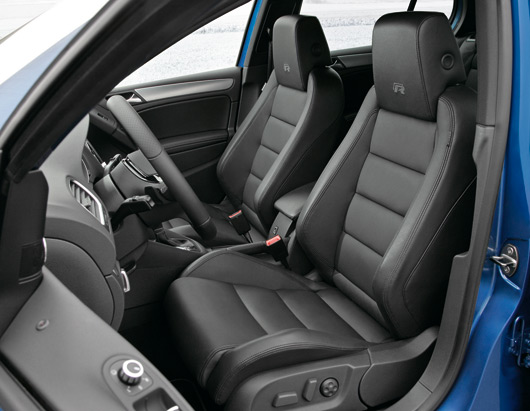
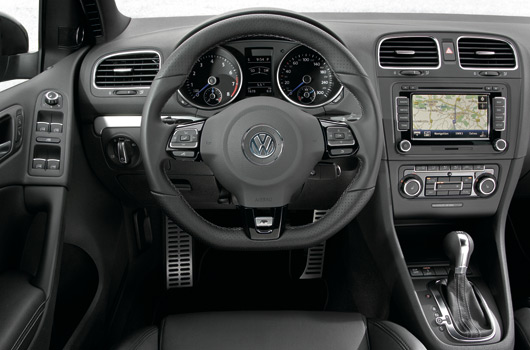
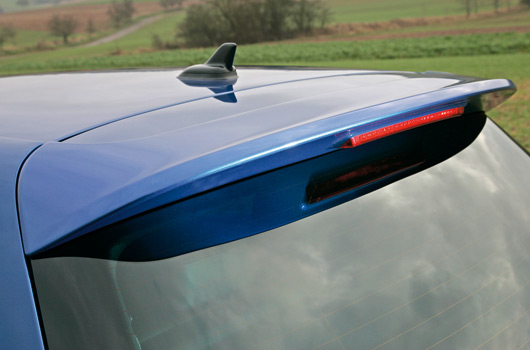
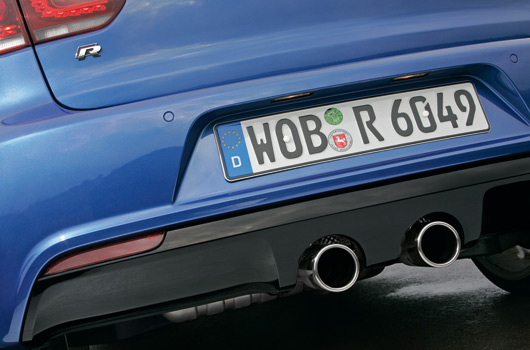
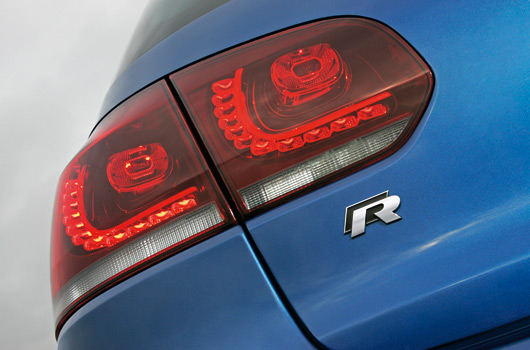
43 replies on “Frankfurt: Volkswagen Golf R”
[…] UPDATE: Official details and images now available HERE. […]
The MkV R32 came out about 6-9 mths after the MKV GTI in Oz so I’ll predict July-August next year.
New GTI pricing should give a lead indcator to the R pricing too. Everything points to maybe $1-$2k over the R32 price – max.
I think I found my next car unless I win lotto and go the RS3!
Definately my next car… time to trade in the mazda!
Matts mums Mk III VR6 > Mk VI R > Mk V R32 > Mk IV R32
Did the R32 ever come in cloth trim worldwide? I noticed the trim on the R is all cloth. This should mean cheaper then the R32, but in the UK it’s more expensive than the S3! What’s the story? Maybe I can get a blue one with beige/tan leather. 😛
Pictures from the floor of the motor show: http://www.motortrend.com/roadtests/hatchbacks/112_0909_volkswagen_golf_r_first_look/index.html
The big issue here in Oz is the pricing for the GTi special edition (s3 motor) and the R32 was way too close to the Audi S3 which is a much better car from a luxury / badge and performance standpoint. Audi more solid, feels and looks better than the golf and has awd turbo – so FANTASTIC news they now share the same motor / driveline combo! well done to VW/Audi!!! Pricing? $55k+???? Looks like they share the s3 brakes now too from a diameter sizing?
Looks like good value. If it sounds like the old R32 then that would seal the deal.
The MK5 pirelli GTI is not the same engine, is it?
Dave, it’s not exactly the same, but pretty close.
Anyone who says the current S3 has the same AWD system as this new Golf R needs educating. The current S3 AWD is the same Haldex system as used in the current R32. No good it’s reactive rather than proactive, hence why an EVO will always have the wood over an S3 or R32 for handling. VW have addressed the criticism of the Haldex system with this new proactive AWD system to reduce understeer. Read the article. I can’t believe people actually believe an S3 is better than this new R. The only thing they share the same is the engine. 195kW isn’t enough anyway, they should of went to town and pulled out 225kW and 400Nm from factory. I hope they keep the pricing down no more than $50-55K. The S3 is way overpriced for a hatchback, add a few options and your pushing close to $80K for an understeering hot hatch, that is pure ludicrous. No wonder Audis cop more hits than the internet when it comes to resale, they drop like a mofo!
The seats in this link look much better
http://www.golfmk6.com/forums/showthread.php?t=2057&page=3
[…] the Peugeot RCZ, a 2+2 coupe that promises both performance and minimal CO2 emissions, and the Volkswagen Golf R, an “Audi S3-lite†that offers a 28 percent emissions reduction compared to itsR32 […]
@Jess: The Mk5 R32 has Gen II Haldex, MY09 and onwards S3s have Gen IV Haldex (also used in the Tiguan IIRC).
So, the AWD systems are the same, but different. It is quite possible that the Golf R’s Haldex system is further advanced over the current setup in the S3, however, getting definitive answers on such matters is not as straightforward as one might expect.
Lima, I don’t think S3 has a separate electric pump for the AWD hardware though…
Way – yes the S3 now has an electric pump – this update to the AWD hardware was arguably the most significant change between the MY08 and MY09 S3’s
Thanks Revhead, I wasn’t aware. This makes the S3 quite a performance bargain then especially in light of the discounting that goes on with those cars…
In relation to my comment from Sep 24 I have since had it comfirmed by Haldex that the Golf R uses the same Gen IV system as the Audi S3 (among others).
[…] UPDATE 15 September: Details have finally been confirmed on the Golf R—CLICK HERE! […]
[…] soon be yours. According to the release below they will now be fitted as standard equipment on the Golf R, GTI and GTD. Buyers of lesser models can option the LEDs, first seen on the Wörthersee GTI, for […]
[…] have taken to the hills of Austria with their eagerly anticipated 199kW all-wheel drive Golf R. Providing music to the ears of Australian fans of this car, we know the new R will be coming here, […]
[…] If true, this will make the third model to boast ‘R’ bragging rights, joining the Golf R and Scirocco […]
[…] their review of the new Golf GTI last year, British e-mag iMOTOR is now showing off in the new Golf R. In a brief written review they claim “the Golf R is brilliant. In fact, it’s the most […]
[…] know the Golf R is coming to Australia, and we know it should be hear by the middle of 2010. What we don’t know […]
[…] T5 (early 2010), new Golf Wagon (March 2010), new Polo (by June 2010), the eagerly awaited Golf R (June 2010) and in late 2010 there will be an updated Touareg and new Amarok […]
[…] assigned to the program Volkswagen R will assume responsibility for existing models such as the Golf R and Sirocco R as well as the R Line and Volkswagen Exclusive range of cosmetic enhancements […]
[…] to AUSmotive reader Ed who has just sent in these two images of the Volkswagen Golf R. The pictures were snapped at Fremantle wharf earlier today. The great news here is that, firstly, […]
[…] Wednesday’s spotting of a 3dr Volkswagen Golf R in Fremantle comes these new pics of another 3dr Golf R from Port Kembla, south of Sydney. The […]
[…] Australia ensured Easter was a happy one for fans of the upcoming Golf R by confirming the 3 door model will join the already confirmed 5 door option. The news was released […]
[…] on the street is the new Volkswagen Golf R will be launched in mid-June. While Australian specs have emerged, there’s still nothing […]
[…] eagerly awaited Volkswagen Golf R is not far from its official Australian launch. AUSmotive understands it will take place in about […]
[…] Australian pricing for the Volkswagen Golf R has been published on the VWWatercooled forum. And, if you’re in the queue for the latest and […]
[…] pricing and specifications for the 188kW Golf R have now been released by Volkswagen. These confirm most of the things we already knew, or […]
[…] new Volkswagen Golf R is being rolled out across Australian dealerships this weekend. The thirst for more information on […]
[…] of the all-paw Golf R first came to light in September last year. Since then there’s been a sense of anticipation […]
[…] – plus all the original marketting photos. AUSmotive.com (the one in blue). Note that in the original marketting photos (in blue in the link above), […]
[…] has revealed four special Golf R models at the Geneva Motor Show. The cars feature a variety of cosmetic enhancements from the full […]
With that price I better buy A5
[…] we can tell you, the Edition 35 runs a de-tuned 2.0 litre turbo from the Golf R. In short, that means the power gain has been achieved by using bigger turbo; much like the Mk5 […]
[…] 30th Wörthersee GTI meet Volkswagen has followed up its GTI Edition 35 by ripping the top off the Golf R. The all-paw Cabriolet translates its special R styling cues onto the regular ragtop Golf and, if […]
[…] The top brass from Volkswagen performance arm, R GmbH, say “The future is diesel and all-wheel drive.” Sure, in current day context that makes perfect sense for a Touareg R, for example. But would punters really cough up for a diesel powered hot hatch, such as the Golf R? […]
[…] Paul Fletcher from the Greater Manchester Police was lucky to walk away from the wreckage of this Volkswagen Golf R after coming to grief during an early morning test […]
[…] Debate surrounds the placement of the exhausts for the next-gen R; will they be quad tipped, with a pair at either side of the car, as these images show, or will VW return to the current centrally mounted twin tips as seen on the Mk6 Golf R? […]
[…] […]